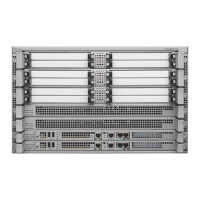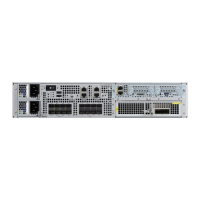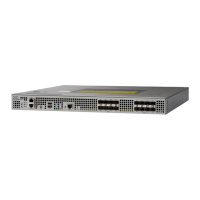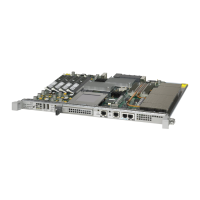13-9
Cisco ASR 1000 Series Aggregation Services Routers SIP and SPA Software Configuration Guide
OL-14127-08
Chapter 13 Configuring the POS SPAs
Configuration Tasks
The following example shows the encapsulation type is HDLC for port 0 on the POS SPA installed in
subslot
0 of the SIP that is located in slot 2 of the Cisco ASR 1000 Series Router:
Router# show interfaces pos 2/0/0
Hardware is Packet over Sonet
Internet address is 10.0.0.1/24
MTU 9216 bytes, BW 622000 Kbit, DLY 100 usec,
reliability 255/255, txload 1/255, rxload 1/255
Encapsulation HDLC, crc 16, loopback not set
Keepalive not set
Scramble disabled
Configuring POS Alarm Trigger Delays
A trigger is an alarm that, when activated, causes the line protocol to go down. The POS alarm trigger
delay helps to ensure uptime of a POS interface by preventing intermittent problems from disabling the
line protocol. The POS alarm trigger delay feature delays the setting of the line protocol to down when
trigger alarms are received. If the trigger alarm was sent because of an intermittent problem, the POS
alarm trigger delay can prevent the line protocol from going down when the line protocol is functional.
Path-Level Triggers
You can issue the pos delay triggers path command to configure various path alarms as triggers and to
specify an activation delay between 0 and 10000 milliseconds. The default delay value is 100
milliseconds. The following path alarms are not triggers by default. You can configure these path alarms
as triggers and also specify a delay:
• Path alarm indication signal (PAIS)
• Path remote defect indication (PRDI)
• Path loss of pointer (PLOP)
The pos delay triggers path command can also bring down the line protocol when the higher of the B2
and B3 error rates is compared with the signal failure (SF) threshold. If the SF threshold is crossed, the
line protocol of the interface goes down.
To configure POS path-level triggers, use the following command in interface configuration mode:
To disable path-level triggers, use the no form of this command.
Verifying POS Alarm Trigger Delays
To verify POS alarm trigger delays, use the show controllers pos privileged EXEC command and
observe the values shown in the “Line alarm trigger delay” and “Path alarm trigger delay” fields.
Command Purpose
Router(config-if)# pos delay triggers path ms Specifies that path-level alarms should act as triggers
and specifies a delay for setting the line protocol to
down when a path-level trigger alarm is received,
where:
• ms—Specifies the delay in milliseconds. The
default delay is 100 milliseconds.

